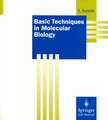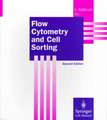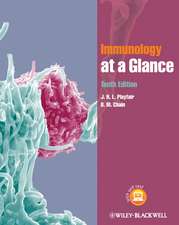Monoclonal Antibodies: Springer Lab Manuals
Desene de R. Gieseler Editat de Johann H. Peters Cuvânt înainte de G. Köhler Traducere de P. Debbage Editat de Horst Baumgartenen Limba Engleză Paperback – 13 dec 2011
Din seria Springer Lab Manuals
-
 Preț: 385.84 lei
Preț: 385.84 lei -
 Preț: 362.59 lei
Preț: 362.59 lei - 18%
 Preț: 973.69 lei
Preț: 973.69 lei - 15%
 Preț: 695.85 lei
Preț: 695.85 lei - 18%
 Preț: 997.40 lei
Preț: 997.40 lei -
 Preț: 385.84 lei
Preț: 385.84 lei -
 Preț: 382.18 lei
Preț: 382.18 lei - 24%
 Preț: 1045.10 lei
Preț: 1045.10 lei - 15%
 Preț: 641.20 lei
Preț: 641.20 lei - 18%
 Preț: 939.33 lei
Preț: 939.33 lei -
 Preț: 381.43 lei
Preț: 381.43 lei - 15%
 Preț: 637.59 lei
Preț: 637.59 lei - 15%
 Preț: 639.25 lei
Preț: 639.25 lei -
 Preț: 376.68 lei
Preț: 376.68 lei - 18%
 Preț: 1822.40 lei
Preț: 1822.40 lei - 18%
 Preț: 953.82 lei
Preț: 953.82 lei - 15%
 Preț: 645.14 lei
Preț: 645.14 lei - 15%
 Preț: 689.93 lei
Preț: 689.93 lei - 23%
 Preț: 821.59 lei
Preț: 821.59 lei - 19%
 Preț: 588.70 lei
Preț: 588.70 lei - 18%
 Preț: 1225.31 lei
Preț: 1225.31 lei - 15%
 Preț: 657.39 lei
Preț: 657.39 lei - 18%
 Preț: 949.73 lei
Preț: 949.73 lei -
 Preț: 386.99 lei
Preț: 386.99 lei - 15%
 Preț: 657.25 lei
Preț: 657.25 lei - 19%
 Preț: 555.63 lei
Preț: 555.63 lei -
 Preț: 380.63 lei
Preț: 380.63 lei - 18%
 Preț: 1226.11 lei
Preț: 1226.11 lei - 15%
 Preț: 649.22 lei
Preț: 649.22 lei - 15%
 Preț: 632.55 lei
Preț: 632.55 lei - 19%
 Preț: 584.77 lei
Preț: 584.77 lei - 15%
 Preț: 639.41 lei
Preț: 639.41 lei - 15%
 Preț: 644.82 lei
Preț: 644.82 lei -
 Preț: 390.25 lei
Preț: 390.25 lei - 18%
 Preț: 781.31 lei
Preț: 781.31 lei - 15%
 Preț: 644.63 lei
Preț: 644.63 lei -
 Preț: 382.36 lei
Preț: 382.36 lei -
 Preț: 363.12 lei
Preț: 363.12 lei - 18%
 Preț: 961.23 lei
Preț: 961.23 lei -
 Preț: 416.29 lei
Preț: 416.29 lei - 18%
 Preț: 783.35 lei
Preț: 783.35 lei - 18%
 Preț: 791.88 lei
Preț: 791.88 lei - 15%
 Preț: 675.22 lei
Preț: 675.22 lei - 23%
 Preț: 1311.58 lei
Preț: 1311.58 lei -
 Preț: 381.43 lei
Preț: 381.43 lei
Preț: 727.44 lei
Preț vechi: 765.72 lei
-5% Nou
Puncte Express: 1091
Preț estimativ în valută:
139.24€ • 151.30$ • 117.04£
139.24€ • 151.30$ • 117.04£
Carte tipărită la comandă
Livrare economică 19 aprilie-03 mai
Preluare comenzi: 021 569.72.76
Specificații
ISBN-13: 9783642745348
ISBN-10: 3642745342
Pagini: 512
Ilustrații: XVII, 488 p.
Dimensiuni: 155 x 235 x 32 mm
Greutate: 0.71 kg
Ediția:Softcover reprint of the original 1st ed. 1992
Editura: Springer Berlin, Heidelberg
Colecția Springer
Seria Springer Lab Manuals
Locul publicării:Berlin, Heidelberg, Germany
ISBN-10: 3642745342
Pagini: 512
Ilustrații: XVII, 488 p.
Dimensiuni: 155 x 235 x 32 mm
Greutate: 0.71 kg
Ediția:Softcover reprint of the original 1st ed. 1992
Editura: Springer Berlin, Heidelberg
Colecția Springer
Seria Springer Lab Manuals
Locul publicării:Berlin, Heidelberg, Germany
Public țintă
ResearchCuprins
1 Introduction.- 1.1 Principles of Cell Hybridization.- 1.2 Properties and Significance of Monoclonal Antibodies.- 1.3 Use of Monoclonal Antibodies in Human Beings: Quality Control and Legal Aspects.- 2 Preconditions for Hybridoma Technology.- 2.1 Experimental Work with Animals.- 2.2 Equipment of the Cell Culture Laboratory.- 2.3 Equipment for Immunological and Biochemical Work.- 2.4 Organization of the Course of Work (Time Table) and Estimation of Costs.- 3 Immunization.- 3.1 Principles and Strategies for Immunizing Animals.- 3.2 Choice of the Immunogen.- 3.3 Immunizing the Larger Experimental Animals for Antisera Production.- 3.4 Immunizing Mice.- 3.5 Influencing the Immune Response.- 4 Taking Blood and Isolating Cells.- 4.1 Taking Blood from Experimental Animals.- 4.2 Isolating Lymphocytes from Spleen and Lymph Nodes.- 4.3 Isolating Human Lymphocytes from Peripheral Blood, Tonsils, or Spleen.- 4.4 Enriching Antigen-Specific Lymphoblasts for Fusion.- 4.5 Isolating Mouse Peritoneal Macrophages for Use as Feeder Cells.- 5 Cell Culture.- 5.1 Requirements for Cell Culture.- 5.2 Additives to Media: Growth Factors, Conditioned Media.- 5.3 Cryopreservation of Cells.- 5.4 Bacterial and Fungal Infections.- 5.5 Limiting an Infection in Multi-Well Plates.- 5.6 Mycoplasmas.- 5.7 Cell Viability Testing Using Fluorescent Dyes.- 6 Production of Hybridomas.- 6.1 Basics.- 6.2 Fusing Cells to Generate Mouse Monoclonal Antibodies.- 6.3 Human Hybridoma Technique.- 6.4 Other Fusion Methods.- 6.5 Calculating the Number of Hybridoma Clones To Be Expected.- 6.6 Culture and Enrichment of Hybridomas.- 6.7 Cloning Cells.- 6.8 Identifying Human Genomic Material in Mouse-Human Hybridomas.- 6.9 Fine-Tuning Hybridomas.- 6.10 Nomenclature of Monoclonal Antibodies.- 7 Mass Production of Monoclonal Antibodies.- 7.1 Mass Production of Monoclonal Antibodies in Cell Culture or Ascites.- 7.2 Production of Monoclonal Antibodies in Mice.- 7.3 Production of Monoclonal Antibodies in Bioreactors.- 7.4 Serum-Free Cell Culture.- 7.5 Checking the Antibody Properties.- 8 Purifying Monoclonal Antibodies and Producing Antibody Fragments.- 8.1 Purification of Monoclonal Antibodies: an Overview.- 8.2 Producing Immunoreactive Fragments from Mouse Monoclonal Antibodies.- 9 Coupling Monoclonal Antibodies.- 9.1 Basic Principles.- 9.2 Conjugation of Enzymes to Monoclonal Antibodies.- 9.3 Biotinylating Monoclonal Antibodies.- 9.4 Conjugating Fluorochromes to Monoclonal Antibodies.- 9.5 Conjugating Monoclonal Antibodies to Solid Phases (Immune Absorption).- 10 Demonstration of Monoclonal Antibodies.- 10.1 How To Find the Correct Monoclonal Antibody.- 10.2 Immunoassays for Soluble Antigens: a Survey.- 10.3 ELISA for Demonstration of Monoclonal Antibodies Against Soluble Antigens.- 10.4 Quantitative Tests to Demonstrate the Synthetic Capacity of Hybridoma Cells.- 10.5 Selection of a Test System for Antibodies Against Cellular Antigens.- 10.6 Immunofluorescence Demonstration of Cytoplasmic Ig in Fixed Lymphocytes.- 10.7 Immunofluorescence Demonstration of Membrane Antigens on Living Lymphocytes.- 10.8 Immunocytochemical Staining Techniques.- 10.9 Immunocytochemical Demonstration of Membrane Antigens on Living Cells.- 10.10 ELISA Demonstration of Antigens in Fixed Cells (Cell ELISA).- 10.11 Local Demonstration of Specific Antibody.- 10.12 Dot Immunobinding Test.- 10.13 Molecular Weight Determination of Membrane Antigens by Means of Chemiluminescence-Autography and Sequential Immunoprecipitation.- 10.14 Depletion of Cells in Suspension by Use of Particle-Bound Antibodies (Magnetic Particles).-10.15 Typing Class and Subclass (Isotyping) of Mouse Antibodies by Means of ELISA.- 10.16 Analytical HPLC of Monoclonal Antibodies.- 10.17 Analytical SDS Polyacrylamide Gel Electrophoresis (SDS-PAGE).- 10.18 Analytical Isoelectric Focusing of Monoclonal Antibodies.- 10.19 Silver Staining of Polyacrylamide Gels.- 10.20 Protein Blotting, Immunoblotting (“Western Blot”).- 10.21 Epitope Analysis.- 11 Safety Precautions at Work.- 12 Appendix.- 12.1 Monographs.- 12.2 Reference Works for Obtaining Cells, Reagents, and Laboratory Equipment.- 12.3 Addresses of Firms.










